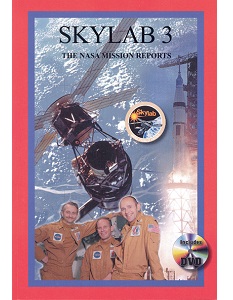Although many people are well aware of the International Space Station, those without a particular interest in space history may not realise that America had a large and capable space station in the 1970s. The Skylab Orbital Workshop was a converted Saturn V third stage, left over from the Apollo lunar programme, and hosted three 3-man crews in 1973 and 1974.
This book – the latest in Apogee’s long-running NASA Mission Reports series – covers Skylab 3, the second of the three manned Skylab missions (Skylab 1 was the launch of the station itself and was the subject, along with Skylab 2, of a previous volume). The signature feature of the Mission Reports series is the ‘bonus DVD’ included with the books. In this case, the DVD includes a launch video, a 14-minute ‘Skylab 3’ mission documentary, a 55-minute guided tour of the station with astronaut Jack Lousma and a ‘digital animation’ of the station. The archive film is fairly low definition in today’s terms but the animation reel provides a clear impression of the station’s interior. Along with the 350-page book, the DVD makes this a good value-for-money package.
The book itself has three main sections: the Skylab 3 press kit from July 1973; the mission report (which fills some 170 pages of the volume); and a transcript of the Technical Crew Debriefing (another 150 pages). The mission report section is illustrated with black-and-white photos and facsimiles of the original line drawings, diagrams and tables; it covers everything from training and medical experiments to food and other consumables. The debriefing is akin to an extended interview and provides readers with invaluable insight not only into a Skylab mission, but to living and working in space in general. Indeed, these Skylab mission debriefs should be required reading for any budding space mission designers.
An important factor for a space station is its size and Skylab compares extremely well with the ISS considering the four decades that separate the two. Taking into account Skylab’s so-called Apollo Telescope Mount (designed for solar observations), an airlock module and a docking adapter, its total volume was some 360m3 (compared with about 930m3 for the ISS).
America’s first space station no longer exists, having long ago re-entered the atmosphere, burnt up and showered Western Australia with the remaining debris. However, this book does a great job in keeping the memory of its significant accomplishments alive.
Mark Williamson











